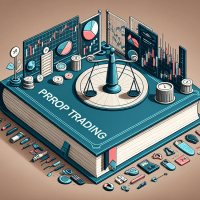Prop Trading Rewards: Expert Strategies for Success
As the prop trading industry evolves, rewards become a key differentiator for firms and traders alike. This comprehensive guide explores advanced strategies for maximizing prop trading rewards, dives into automated backtesting tools, and provides real-world case studies to enhance your trading performance.
Understanding Prop Trading Rewards
Prop trading rewards extend beyond simple bonus structures. They include profit-sharing, loyalty programs, and incentive-based challenges designed to reward performance consistently. In today’s competitive landscape, traders and firms must structure rewards that align with strategic goals. This article explores effective techniques and offers practical insights to optimize your rewards framework.
This visual illustrates a typical prop trading framework where tools and strategies converge to enhance performance metrics, such as the Sharpe ratio and profit factor.
Key Strategies to Maximize Your Rewards
For both junior traders and seasoned quants, the following strategies can help boost your prop trading rewards:
- Risk-Adjusted Performance Metrics: Focus on metrics like the Sharpe ratio, maximum drawdown, and profit factor to balance aggressive growth with measured risk control.
- Leveraging Automated Backtesting: Use advanced backtesting tools to refine strategies in a simulated environment. This process eliminates overfitting and look-ahead biases, ensuring that your live trades are based on robust data.
- Walk-Forward Analysis: Transition from traditional backtesting to walk-forward optimization. This method validates strategy performance over evolving market conditions.
- Out-of-Sample Testing: Reserve a portion of historical data as unseen data to truly test the resilience of your strategies.
- Integrating Forward Testing: Pair backtesting with paper trading to transition smoothly into live markets, monitoring key performance metrics in real time.
Automated Backtesting Tools for Prop Trading: In-Depth Comparison
Selecting the right backtesting platform is critical. Below is a comparison of widely recognized tools used by prop trading professionals:
| Tool | Backtesting Features | Data Quality | Integration | Pricing & Use Cases |
|---|---|---|---|---|
| TradingView | Vectorized backtesting with script customization and automated alerts | Rich historical data across multiple asset classes | API access and broker integration | Freemium model; ideal for retail traders and initial prop firm testing |
| MetaTrader 5 | Event-driven testing, deep historical data testing with commission/slippage simulation | Comprehensive forex and CFD data | Broker and third-party integration | Free with brokers; suitable for both retail and professional prop trading environments |
| NinjaTrader | Advanced automated strategy testing with optimization capabilities | High-quality, real-time and historical data feeds | Extensive API and add-on functionality | Subscription-based; tailored for professional traders needing rigorous backtesting |
| QuantConnect | Algorithmic backtesting capable of multi-asset class simulations, automated parameter optimization | Deep tick data and comprehensive coverage | Integration with brokers and machine learning frameworks | Free tier available; optimal for institutional level prop trading and quant research teams |
Each of these tools automates not just the backtesting process but also advanced tasks like scenario analysis and stress testing, which are critical when assessing the viability of a strategy within a prop firm setting. Read our full guide to advanced trading strategies for further insights.
Expert Guidance: Advanced Backtesting Considerations
Backtesting in prop trading requires more than just running historical data through a model. Consider these expert tips:
- Mitigating Overfitting: Regularly change in-sample and out-of-sample periods helps avoid biases resulting from overfitting your model to historical data.
- Identifying Survivorship Bias: Incorporate data sets that account for companies and instruments that have failed over time to develop realistic strategies.
- Using Walk-Forward Optimization: Continuously update strategies by using rolling training windows, ensuring adaptability in changing market conditions.
- Maintaining Data Integrity: Always use high-quality tick or bar data, adjust for corporate actions, and be wary of incomplete data that may skew results.
This screenshot demonstrates how automated backtesting tools such as NinjaTrader and QuantConnect present clear, actionable reports highlighting essential performance metrics.
Real-World Case Study: A Prop Trading Firm Success Story
Consider a leading prop trading firm that recently overhauled its trading strategy using advanced backtesting tools. The firm integrated TradingView and QuantConnect to optimize its reward structure based on risk-adjusted performance.
Challenge: The firm faced persistent drawdown issues, with a maximum drawdown exceeding acceptable thresholds. They needed more rigorous strategy validation and optimization to safeguard capital.
Solution: The firm implemented robust out-of-sample and walk-forward testing procedures. By dual-testing with TradingView for initial strategy iterations and QuantConnect for in-depth multi-asset simulations, they fine-tuned parameters to boost the Sharpe ratio by over 30% and reduced drawdowns by nearly 20% within six months.
Result: The improved model enhanced profit-sharing outcomes and attracted top talent through a refined rewards structure that included performance-based bonuses and loyalty incentives. This real-life success underscores the importance of integrating rigorous backtesting with innovative reward systems.
Integrating Forward Testing with Live Trading
After extensive backtesting, always transition into forward testing or paper trading. This phase allows you to monitor live market behavior without risking capital. Key performance indicators (KPIs) such as drawdown limits, profit factors, and the Sharpe ratio should be tracked vigilantly for any strategy adjustments.
For comprehensive insights on managing risk and integrating forward testing, consider exploring our Guide to Risk Management.
Next Steps: Enhance Your Prop Trading Strategy
As markets continue to evolve, staying ahead with rigorous strategy testing and reward optimization is crucial. We recommend downloading our detailed Risk Management Checklist – complete with a trading journal template and performance review framework – to further refine your strategy.
For continual updates and detailed backtesting case studies, keep exploring our content. Join our upcoming webinar on advanced prop trading techniques and subscribe for the latest tools and trends in this dynamic field.
Sample Code: Python Snippet for Backtrader
import backtrader as bt
class TestStrategy(bt.Strategy):
def __init__(self):
self.dataclose = self.datas[0].close
def next(self):
if not self.position:
if self.dataclose[0] < self.dataclose[-1]:
self.buy()
else:
if self.dataclose[0] > self.dataclose[-1]:
self.sell()
cerebro = bt.Cerebro()
cerebro.addstrategy(TestStrategy)
# Add data feed and run
cerebro.run()
Additional Resources
For further reading on optimizing automated backtesting in a prop trading environment, check out our resources on advanced strategy testing and risk management methodology. These detailed guides provide actionable insights and practical frameworks for establishing a robust prop trading operation.







